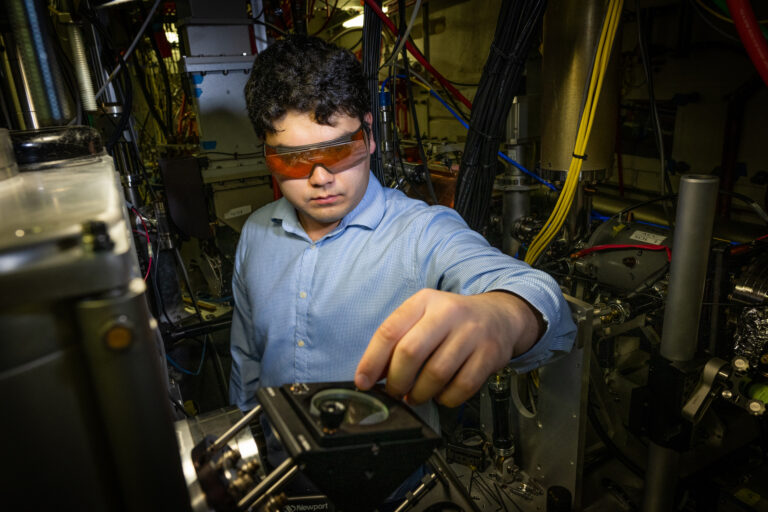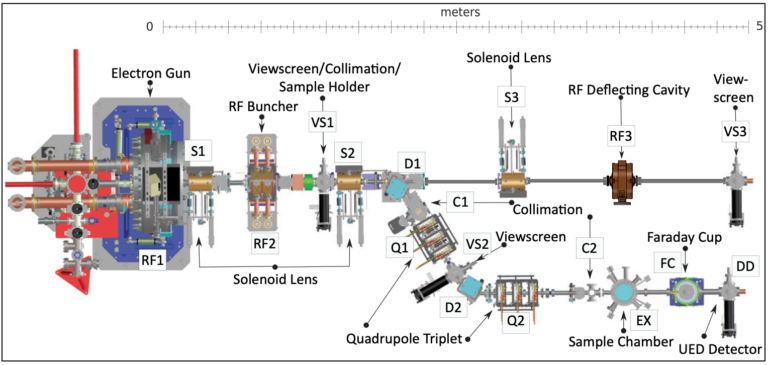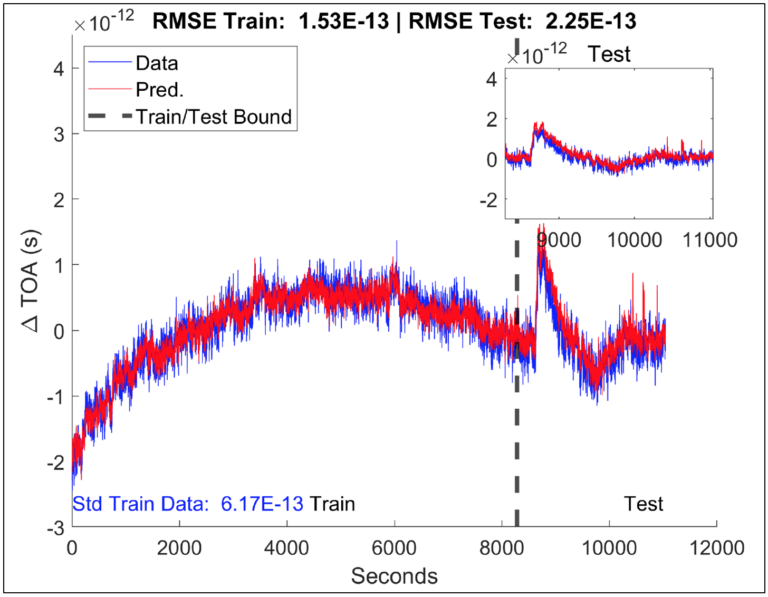ATAP Researchers have used the HiRES beamline to develop a new diagnostics tool for enhancing the capabilities of ultrafast electron diffraction—a powerful technique that promises breakthroughs in scientific research.

Eric Cropp, a graduate student researcher at ATAP, works at the Advanced Light Source High-Resolution Accelerator (HiRES), an electron accelerator at Berkeley Lab. (Credit: Paul Mueller/Berkeley Lab)
A team of researchers led by scientists at the Accelerator Technology & Applied Physics (ATAP) Division at Berkeley Lab has developed a new diagnostics tool that could improve the performance of ultrafast electron diffraction (UED). Using beams of electrons to probe atoms and molecules, UED is a powerful technique that provides valuable information on their structural dynamics. It could advance fundamental scientific research and enable discoveries in material science, chemistry, and biology.
In UED, ultrafast laser pulses lasting less than a picosecond (a trillionth of a second) induce chemical, electronic, or structural changes in a sample. An electron pulse is then directed at this sample and diffracts after interacting. Adjusting the arrival time of the laser and electron pulses produces a series of diffraction patterns at different time intervals. These diffraction patterns can then be combined to create a “movie” of the structural changes in the atoms.
While the technique is an effective method for probing the evolving dynamics of matter with a high temporal resolution, "a data-driven approach can further improve temporal resolution and extend the capabilities of UED," says Eric Cropp, a graduate student researcher at ATAP and the University of California, Los Angeles, who led the development of the diagnostic tool.
"The temporal resolution of the technique is determined by a combination of many parameters, which include the length of the laser pulses and electron beams; however, fluctuations in the time-of-arrival (TOA) of the electron beam relative to that of the laser pulse adversely affect the temporal resolution and can become the limiting factor for applications like UED."
These fluctuations, he adds, have both a short-term (jitter) and long-term (drift) component and are caused by many factors. These include movements in the laser used to produce the electron beams, fluctuations in the radio frequency cavities that accelerate the electrons, and variations in the magnetic fields used to steer and focus them.

The UED beamline starts at D1 and goes through the dogleg to DD, while the diagnostic beamline goes straight from D1 to VS3. (Credit: Berkeley Lab)
While today's accelerators use closed-loop feedback systems to mitigate jitter, Cropp says these systems "still allow for a certain amount of fluctuation, which must be addressed to achieve optimal temporal resolution." Such systems, he adds, are also typically limited to monitoring just one variable and cannot track movements in two or more of the machine's parameters relative to one another.
"Moreover," he continues, "measurements of the beam TOA are usually accomplished using destructive methods, which means that the measured beam cannot be used for UED. The shot-to-shot fluctuations in the beam can make these TOA measurements less useful."
Faced with these limitations, the researchers turned to a new approach that uses virtual diagnostics and machine-learning techniques, which allow for the non-destructive monitoring of the beam dynamics and have shown promise for tackling control and diagnostics problems in accelerators.
To build a virtual diagnostics tool, the team used the Berkeley Lab HiRES accelerator beamline at the Advanced Light Source to collect data on the downstream properties of the beam, including energy and TOA. Then it correlated these with the upstream accelerator parameters. The HiRES beamline serves as a UED beamline and an R&D testbed for such activities.
They then used a linear regression model to predict the TOA of the beam on a deflecting cavity. This resulted in "a 225-femtosecond uncertainty in the TOA, which translated to a nearly-threefold improvement over the long-term fluctuations of the beam," says Cropp.
"We then predicted the energy fluctuations in the beam, which are strongly related to TOA (in this energy range, slower, lower-energy beams arrive later than faster, higher-energy ones) and found that the quality of the predictions matched reasonably well."
;">
Time of arrival (TOA) fluctuations were measured using a transverse deflecting cavity while the PID-type feedback was engaged. The upper right insert shows the linear regression analysis. (Credit: Berkeley Lab)
According to Cropp, this data-driven technique demonstrates "an effective method for improving the temporal resolution of UED, and could further enhance the technique's capabilities. The technique, he adds, is also broadly applicable where any measurement that requires knowledge of the beam time of arrival or energy could benefit from noninvasive time- or energy-stamping techniques. " As such, upcoming tests of novel photocathodes in the HiRES' state-of-the-art electron gun could benefit from the technique, and the approach will be directly applicable to upcoming nano-UED work at HiRES."
Finally, the researchers combined the linear regression approach with a machine-learning-based forecasting technique, which incorporated an attention-based transformer that weighs the significance of the input data, further improving the accuracy of the predictive model.
They plan to improve the performance of the diagnostic tool by using increasingly larger datasets to train the machine learning model. Such model-based approaches "have direct application to upcoming projects at HiRES, including the testing of novel photocathodes in HiRES's unique electron gun and more directly toward nano-UED at HiRES," says Cropp.
"This research shows how the ALS HiRES beamline is already providing ATAP researchers with the tools needed to extend the capabilities of accelerator-based applications and points the way to new projects using the beamline that aim to enable deeper insights into the properties and structures of the building blocks of matter as well as new components for accelerator facilities," said Cameron Geddes, ATAP Division Director.
To learn more: Cropp, F., Moos, L., Scheinker, A. Gilardi, A., Wang, D., Paiagua, S., Serrano, C., Musumeci, P., and Filippetto, D. “Virtual-diagnostic-based time stamping for ultrafast electron diffraction,” Phys. Rev. Accel. Beams (2023), https://doi.org/10.1103/PhysRevAccelBeams.26.052801
News from: https://atap.lbl.gov/timing-is-everything-for-new-diagnostics-tool/


